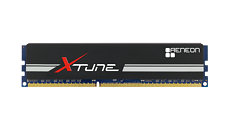Friday, March 21st 2008
Qimonda Brings New Power Efficient Aeneon XTUNE DDR3 to NVIDIA nForce 790i SLI
Qimonda AG today announced it is supporting NVIDIA Corporation's nForce 790i SLI platform with its new 1GB Aeneon XTUNE DDR3-1600 DRAM modules. The combination of NVIDIA's first DDR3 ready platform and Qimonda's DDR3 memory technology offers gamers a path to intelligent scaling of graphics performance.Qimonda has tested its Aeneon XTUNE 1GB DDR3 modules at overclock rates greater than 1680 MHz using a nominal supply voltage of 1.5V. The ability to provide high-level gaming performance at low voltage reduces the amount of power consumed and the heat generated, which reduces cooling requirements and can enhance system reliability and life expectancy.
"Gamers constantly look for ways to stretch system performance to get the best experience, and running system components at greater than specified speeds is a common technique for achieving that goal," said Bryn Young, Director Memory Sales and Marketing, NVIDIA Corporation. "Qimonda has demonstrated its XTUNE DDR3 memory modules operating at impressive overclock rates while maintaining the nominal 1.5V supply voltage."
"Qimonda leverages an inherent power saving advantage in its chip design, along with module design experience, to allow overclockers to reach maximum performance," said Dr Carsten Gatzke, Vice President of Qimonda's Channel and Retail Business Unit. "In conjunction with the NVIDIA nForce 790i SLI platform, the Aeneon XTUNE modules will allow gamers to obtain maximum enjoyment from their systems. This support is significant as it reflects our commitment to make our foray into the gaming market with the Aeneon XTUNE series which is specifically developed for the PC gamers and enthusiasts."
Technical information on Aeneon XTUNE DDR3-1600
The new XTUNE DDR3-1600 is developed to harness the full potential of the latest chipset in the market including NVIDIA nForce 790i SLI platform at a power efficient mode. The memory module is available as 2x1GB kit. It is tested to run at 1600MHz at a latency timing of CL9 with the low supply voltage of 1.5V, providing a bandwidth of up to 12.800 MByte/s on module level. The memory modules also feature the Enhanced Performance Profile 2 (EPP2) to perform their full potential when used in the NVIDIA nForce 790i SLI platform.
Availability and pricing
The XTUNE DDR3-1600 Dual Channel Kit (2x 1GB) is available now through the authorized Aeneon sales representatives and distributors for US$ 340.
Source:
Qimonda
"Gamers constantly look for ways to stretch system performance to get the best experience, and running system components at greater than specified speeds is a common technique for achieving that goal," said Bryn Young, Director Memory Sales and Marketing, NVIDIA Corporation. "Qimonda has demonstrated its XTUNE DDR3 memory modules operating at impressive overclock rates while maintaining the nominal 1.5V supply voltage."
"Qimonda leverages an inherent power saving advantage in its chip design, along with module design experience, to allow overclockers to reach maximum performance," said Dr Carsten Gatzke, Vice President of Qimonda's Channel and Retail Business Unit. "In conjunction with the NVIDIA nForce 790i SLI platform, the Aeneon XTUNE modules will allow gamers to obtain maximum enjoyment from their systems. This support is significant as it reflects our commitment to make our foray into the gaming market with the Aeneon XTUNE series which is specifically developed for the PC gamers and enthusiasts."
Technical information on Aeneon XTUNE DDR3-1600
The new XTUNE DDR3-1600 is developed to harness the full potential of the latest chipset in the market including NVIDIA nForce 790i SLI platform at a power efficient mode. The memory module is available as 2x1GB kit. It is tested to run at 1600MHz at a latency timing of CL9 with the low supply voltage of 1.5V, providing a bandwidth of up to 12.800 MByte/s on module level. The memory modules also feature the Enhanced Performance Profile 2 (EPP2) to perform their full potential when used in the NVIDIA nForce 790i SLI platform.
Availability and pricing
The XTUNE DDR3-1600 Dual Channel Kit (2x 1GB) is available now through the authorized Aeneon sales representatives and distributors for US$ 340.

12 Comments on Qimonda Brings New Power Efficient Aeneon XTUNE DDR3 to NVIDIA nForce 790i SLI
Now, if we had samsung chips...
Qimonda is cheap, that's why they screwed us. I'm sorry, but I'll pay a few dollar premium for the best parts. I don't go out and buy an import with a american parts in it, do I? LOL
Unfortunately my few extra dollars stop at the GTS' price haha. I think it's the best bang for the buck, but you know, with gov't forcing us into a depression and all, it's a little expensive.
But alas, I agree I'd rather have the Samsungs, if nothing else than for the piece of mind knowing that i can OC the snot out of them if I desire. lol.
And my monitor can do 2500x1600 ;)